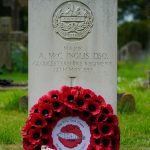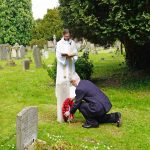A service was held at Prestbury St Mary to commemorate Arthur McCullock Inglis. The photos below were provided by Stephen Pope who attended the event and said:
“The Prestbury parishioners provided a wonderful welcome on Sun 12 May; a great deal of effort had been taken to mark each of the Great War casualties who were either buried or remembered in the churchyard and Father Nick provided a stunning commemorative service.”
Mr Pope has also allowed us to reproduce the article below which he wrote for the Prestbury Parish Newsletter and points out a few assumptions we made in our previous article (namely that Arthur had died from his wounds).
Major Arthur Inglis – the Glosters’ officer who won the first Tank Corps DSO
Although fighting in the Great War ceased on the Western Front on 11 November 1918, it did not end the suffering for wounded soldiers or their families. Many succumbed to their wounds, countless died as a result of the influenza epidemic which swept across Europe whilst others, weakened by their military service, died of linked causes. One of these was the Prestbury resident, Major Arthur Inglis, an officer of the Glosters who fought with the First Tank Crews.
His life, and those of the thirteen other Prestbury fatalities, will be commemorated at St Mary’s Church after Sung Eucharist on the centenary of his death, Sunday 12 May.
Arthur was the younger son of Lionel and Agnes Inglis. His father, born in India, was a merchant and government official, and later served in the Lancashire Militia; his mother was born near Hereford, and was married in Ashchurch when she was just 19. Arthur’s older brother, also Lionel, was born in 1882 and Arthur was born on 14 July 1884, at the Caledonian Hotel, Inverness; I have not discovered why this happened, but his middle name is McCulloch! For a brief period the family lived at Inglesby, New Barn Lane, from where Arthur attended Cheltenham College. In 1898 Agnes and Lionel travelled to India, where they met Maud Hemmingway, a 25-year-old spinster with whom Lionel became infatuated. He became abusive and violent to Agnes, who obtained a divorce and custody of their two sons.
During the Second Boer War the seventeen year old 2nd Lieutenant Arthur was commissioned into the Wiltshire Regiment. He did not see any fighting but served on the island of St Helena guarding over 5,000 Boer prisoners of war. Returning home Arthur could not settle to civilian life and in 1906 returned to the Regular Army, joining the 2nd Battalion Gloucestershire Regiment. After his first posting, to Warley, Essex, he served on garrison duties in Malta before, in December 1911, he was appointed aide-de-camp to the Governor of The Gambian Colony. Two years later he joined The Gambia Company of the West African Frontier Force. When the Great War broke out the Allies decided to subdue all German colonies worldwide, including Kamerun, in West Africa. Here Captain Arthur Inglis joined the successful Anglo-French invasion force and then became the Camp Commandant at the formation base.
In May 1916, as Arthur returned to the UK, the first tank companies were being created, and he was appointed as a section commander in July; two months later his company was deployed to France. On 15 September 1916, when tanks were used for the very first time, Arthur’s section supported the Canadian Corps at Courcelette. His tanks cleared German trenches and Arthur’s own tank, Crème de Menthe, broke into a heavily fortified sugar factory which helped the Canadians to take this strong point. For his leadership and determination Arthur was awarded the Distinguished Service Order – the first of its type awarded to a tank officer.
In December 1916, as the tank force was being expanded, Arthur was posted to Bovington Camp, Dorset, to form a new tank company. Returning to France, in May 1917, Major Inglis successfully led his tanks during the 3rd Battle of the Somme (Battle of Passchendaele). He commanded his company during the Battle of Cambrai where, within six hours, his tanks broke through the German lines and reached the outskirts of the city. As the tank units were reorganised and expanded further Arthur’s commanding officer, and other majors, returned to England, but Arthur remained in France with his battalion, now re-equipped with the new lighter Whippet tank. The Whippets’ role was to support the Allied cavalry once the infantry had broken through the German defences.
On the opening day of the Battle of Amiens, 8 August 1918, the tanks were successful. Arthur’s company, which was held in reserve to exploit any breakthrough, was ordered to advance. As they moved off one of the tanks drove over an unexploded shell and the shrapnel seriously wounded Arthur and his CO. They were sent back to London for treatment and, as Arthur improved, he was employed on light duties as a Railway Transport Officer. Sadly, in early 1919, Arthur was diagnosed with cancer. Returning to his home in Prestbury Arthur was treated at the Royal Nursing Home at Cheltenham, where he died, aged 34, on 12 May 1919; he was buried in his local Parish Churchyard. His mother and brother lived on in Prestbury, Agnes died in 1923 and his brother Lionel in 1966.
The lives of those who fought in the First Tanks was for many years overlooked. At the centenary of their first action, 15 September 2016, relatives and friends formed a research group to keep their memories alive. Arthur Inglis’ war service is not forgotten – We Remember Him Still!
Article written by Stephen Pope



Leave a Reply